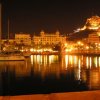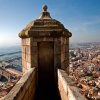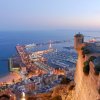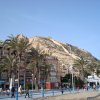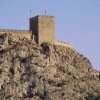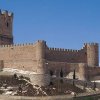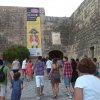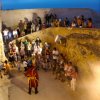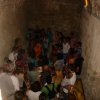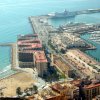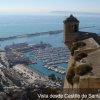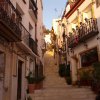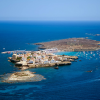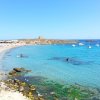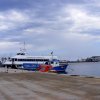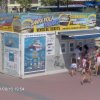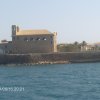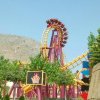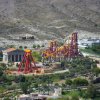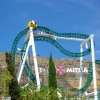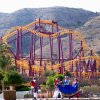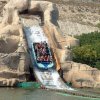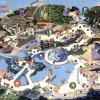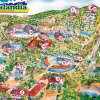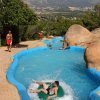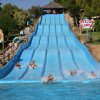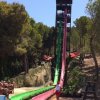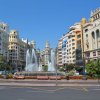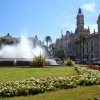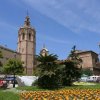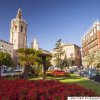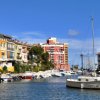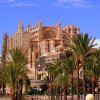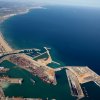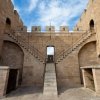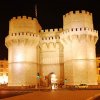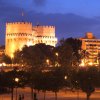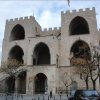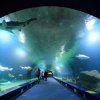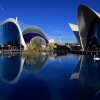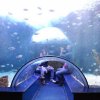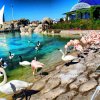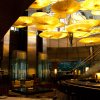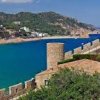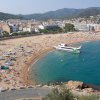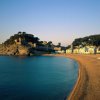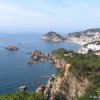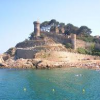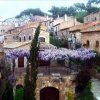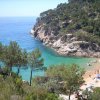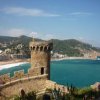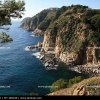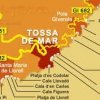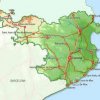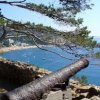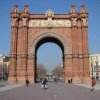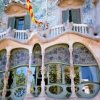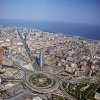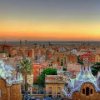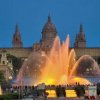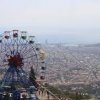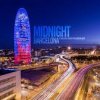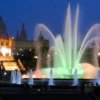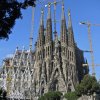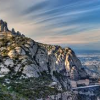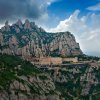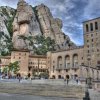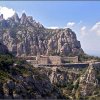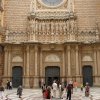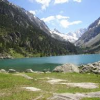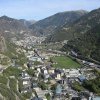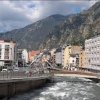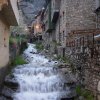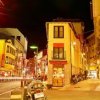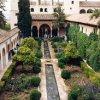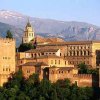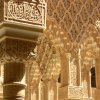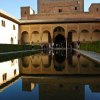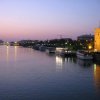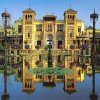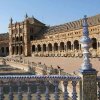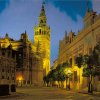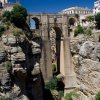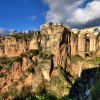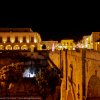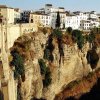Alicante castle
Santa Barbara Castle: 1000 years of History
Alicante boasts many treasures. And among its most prominent is indisputably the Castle of Santa Bárbara, which stands on Mount Benacantil overlooking the city. Hewn from millenary stone, this fortress has witnessed centuries of history in this ancient city – and even played a leading role in several chapters.
Officially declared a Historical-Artistic Monument and Asset of Cultural Interest in 1961, Santa Bárbara Castle is one of the most well-known landmarks in Alicante, and the most visited. Perched 166 metres above the city, it affords some of the greatest views of Alicante, its bay and the vast Mediterranean stretched out at its feet. But it's the castle's history that will captivate you most: a lot can happen in 1,200 years...
Santa Bárbara castle is shrouded in legends and stories. Some are fantastical, while others – such as when French troops blew up the mine – go to prove that truth can indeed be stranger than fiction. And you can hear a lot of these stories if, like us, you take the theatrical tour of the castle. Guided by Sara and various other characters, you will be transported back in time for an hour, back through centuries of splendour, wars, battles, love affairs and exiles...
Our adventure begins next to the car park, in the largest of the six cisterns that once supplied the castle – and up to 14,000 soldiers, at one point – with water. This construction dates back to the 16th century and, with its very high ceilings, has been hewn out of the rock in such a way as to provide a form of natural air conditioning, keeping the cistern at a pleasant and consistent temperature. Here we learn curious facts such as how limestone was rubbed on the walls to keep them waterproof and how carp were released into the water to keep it clean.
Upon exiting the cistern we meet our first character: Jacinta "La Emperadora" or Jacinta "The Empress", a beggar woman who brings to life one of the most recent chapters in the castle's history, the 1950s, when Santa Bárbara was abandoned and became a refuge for the city's poor. Jacinta entertains us with tales of what these unusual inhabitants would get up to, and weaves in two of the legends that surround the castle. First up is the legend of La Cara del Moro or The Face of the Moor, which tells of the star-crossed love between Alí and Princess Cántara. Its tragic end, which sees the princess throw herself from the castle on top of Mount Benacantil because she cannot have the man she loves, left behind the face of a Moorish man carved into the rock – turban and all – visible from El Postiguet beach.
Historical fact meets popular legend in the story of Nicolás Peris, the one-time governor of Santa Bárbara who battled so staunchly to prevent the fortress from falling into the hands of Jaime II in 1256 that he died with the keys in his hand, clutching them so tightly that the only way to prise them free was to cut off his hand. To this day, it is said that on some nights the governor's wails can still be heard, as he laments the loss of his beloved castle.
Next stop on the itinerary is the dungeon: a cold and gloomy place in which visitors are introduced to characters who tell of the 50 prisoners held there in the dungeon during the Spanish Civil War. One by one, these prisoners scratched their names into the stone using a nail which they passed around – graffiti which can now be found set into the floor of one of the castle's lookout points. Instruments of torture and death are on display around the cramped and dingy dungeon, providing an atmospheric backdrop for the stories narrated by the guide.
This theatrical tour brings the past to life, highlighting the main chapters in the castle's history through the use of actors. Enter Remigio el Bombas, an artilleryman from the Spanish War of Independence. He recounts, among other things, the story of how the castle's Chapel of Santa Bárbara was blown up, claiming 70 lives, including that of the then governor. And he gives this account from up in the ruins of La Tahona, the old flour mill, gesticulating wildly below the gunpowder store. Nearby, you can still see old millwheels, if you look closely.
Sunset creeps upon us, painting the sky red as we continue our tour. We enter one of the halls in the castle, where, amongst the coats of arms, another historical figure, Doña Violante de Aragón, tells us how she managed to deflect the pressures put upon her by her anxious husband, Alfonso X El Sabio,to bear him an heir – an heir who would consecrate the alliance between the kingdoms of Castile and Aragon – by feigning a pregnancy that did not, unsurprisingly, reach full term. Violante's somewhat humorous account is tempered by our guide, Sara, who provides the appropriate historical rigour, and it is with a sigh of relief that we, the audience, learn that the couple then went on to have 10 children.
Just a few metres away, in the moat, we meet the final character: Marshal Claude d'Asfeld, protagonist of the explosion in the mine during the War of the Spanish Succession. Speaking with a thick French accent and dressed in period clothing with a sword in his hand, the actor reveals the ins and out of this, one of the most famous – and most incredible – events in the castle's history, in which French troops placed 1,500 hundredweight of gunpowder in the mine in order to force out the English troops stationed in the castle. The fuse was lit on 28th February 1709, while the English were enjoying a gala dinner right on top of the mine – having scoffed at the French marshal's threat to blow up the castle's mine. While the English may not have taken very seriously the 72-hour ultimatum to leave the castle, they did construct a countermine which helped dampen the explosion but which failed, however, to avert the resulting massacre. Nevertheless, the English managed to hold out against the French siege for 46 days. And, of course, Sara the tour guide is there once again to put the event into its historical context and provide further details and explanations.
The tour is now over, and several visitors stay behind to ask Sara questions, which she answers with ease. The castle is lit up, and in such a way as to evoke an idea of what it must have been like to live there during the various periods of its history – periods brought alive by Sara and the actors. The bay cannot be seen, but you can sense its presence, and a feeling of great and joyful freedom on high. On the sea-Facing slope of Mount Benacantil is the Ereta park, an attractive open-air space with a restaurant, cafeteria and exhibition hall.The park offers superb views of the city and its Old Quarter, which can be reached easily via the various entrances to the park.Curiously, when viewed from El Postiguet beach, Mount Benacantil looks like a human face in profile which is known as "La Cara del Moro" or "The Moor's Face" and is one of the city's most emblematic images.
Alicante - Benidorm Terra - Mitica
Alicante - Benidorm - Aqualandia
Valencia
What to visit in Valencia
10 spectacular must-sees that you won't want to miss...
The City of Arts and Sciences
The work of Valencia's own Santiago Calatrava, this is an example of architecture at its most futuristic. The colossal structure houses an IMAX cinema (situated in the Hemisfèric), as well as Europe's largest aquarium – the Oceanogràfic, interactive educational exhibits in the Príncipe Felipe Science Museum and the avant-garde opera house - Palau de les Arts Reina Sofía. Furthermore, the impressive l'Assut de l'Or bridge and the Agora are all a delight for the senses.
Barrio del Carmen and its mansion houses
This ancient district of the city grew between two walls; the Islamic and the Christian city walls. A wander through these labyrinthine cobbled streets, lined with towering mediaeval buildings will transport you back in time to another era in history. Enter the mansion houses, cross the mediaeval gates of the Serrano and Quart towers, and meander into every corner – don't miss it!
Plaza de la Virgen and the cathedral quarter
Twenty-one centuries of history right at the heart of the city, where you'll find such historical treasures as Valencia Cathedral, the Micalet, the Basilica of the Virgin and the Almoina. Don't miss the Tribunal de las Aguas (Water Court), a UNESCO Intangible Cultural Heritage (noon on Thursdays).
Plaza del mercado y Lonja de la Seda (Silk Exchange)
Immerse yourself in one of Europe's biggest markets, the Mercado Central, situated inside a jewel of pre-modernista architecture, and enter into one of the most iconic examples of Gothic architecture in Europe, the Lonja de la Seda, declared an Intangible Cultural Heritage site by UNESCO. As well as these, make sure you squeeze in the Santos Juanes Church.
Museums
34 museums to choose from, offering art, history, architecture... TSoak up 18th century Valencia at the Museo Nacional de Cerámica (National Ceramics Museum), situated in the Palacio del Marqués de Dos Aguas. Muse over pieces by Sorolla, Goya or Zuloaga in the Museo de Bellas Artes San Pío V, get familiar with the Fallas in the Museo Fallero or contemplate the contemporary art pieces on offer at the IVAM and the MUVIM.
Plaza del Ayuntamiento.
In a triangular layout, eclectic architecture, a central fountain and colourful flower stalls brighten the landscape. It's surrounded by some of the city's most iconic buildings, such as the Plaza de Toros, the Estación del Norte, the Ayuntamiento de Valencia (town hall), the Edificio de Correos (post office) and Plaza Redonda, to name but a few. It's best known for playing host to the "mascletàs" celebrations, which take place during March, and during the Fallas.
The Royal Marina and Valencia's beaches
The Juan Carlos I Royal Marina is one of the city's most important landmarks, not only due to the events that are held there, but also due to its unique buildings. It houses the 19th Century Harbour Sheds, the Edificio del Reloj and the Veles e Vents building, the emblem of the new Marina. There are also shops, terraces and restaurants with spectacular views, as well as a children's park, the Superyachts Berthing with its amazing yachts, and the North and South Marinas, filled with numerous boats.
Just a few metres away are the beaches of El Cabanyal (Las Arenas) and La Malvarrosa, next to the attractive Paseo Marítimo promenade. We suggest you try a delicious paella in one of the seafront restaurants, or have a drink in one of the bars. For those who prefer a wilder kind of beach, we recommend El Saler, next to the Albufera Natural Park.
The Albufera Nature Park
The Albufera Nature Park will transport you to a world of untouched, pure nature where the only sounds you'll hear are the birds singing and the sound of the water. Unspoiled by and protected against man, the reserve is located just 10 km out of the city. A visit here will show you the Valencian passion for the environment and help you to discover the origins of our gastronomy.
The Turia Gardens
A garden covering 9 km and situated on the old bed of the River Turia. This is a true green area, stretching from the west of the city to the east, reaching as far as the City of Arts and Sciences. Explore by bicycle or train. Also absolutely worthwhile is a pit stop at the Palau de la Música, pausing to enjoy the unique bridges which cross it from north to south.
Bioparc and Oceanogràfic
From east to west, Valencia is brimming with activities – both leisure and educational – to familiarise you with the animal kingdom, with such activities as an African safari through the Bioparc or a tour of the underwater world in Oceanogràfic, where you'll be able to see tropical fish from as far as the Arctic and the seas of Japan. Get the 'nature pack' for lots of great offers.
Tossa
Barcelona
Montserrat
Andorra
Andaluzia
Sevilla
Ronda

